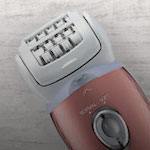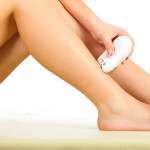What to look for when choosing your perfect epilator - a complete guide
Written by Advice Team on January 28, 2018
Most women can relate to the disappointment of touching their legs just a few hours after shaving and feeling the prickle of stubble returned already. That’s why shaving can feel like a bit of a chore when considering the preparation, time, and care that went into the process.
That’s where epilators are different. They’re convenient, they’re not as time-consuming as people think, and the more they’re used, many women find that their hair becomes thinner and fewer.
What is epilating
Epilating means using an epilator tool to remove hair from the root rather than cutting the hair with a blade. Epilating leaves the skin smooth and lasts between 3 to 6 weeks.
What to expect
Smoothness
It’s unlikely that you’ll have completely smooth legs when you first start epilating. That’s not to say you’re doing it wrong or the epilator isn’t working. Hair grows in different cycles and after epilating, hairs that hadn’t quite reached the surface yet might appear. If hairs appear after epilating, epilate the area 2-3 days after, so you can try to sync hair growth cycles.
If you’re new to epilating then we’d recommend using the epilator every 1-3 weeks for the first few times to match hair growth cycles. Some women find that the hair grows back finer overtime and in some instances doesn’t grow back at all.
Pain threshold There is no denying that epilators can be painful the first few times they’re used. The hair is being removed from the root and you’re essentially tweezing multiple hairs at once. Try epilating after a hot bath when the hair follicles have opened and the skin is softer. Don’t forget to exfoliate often, too. By exfoliating, you’ll help to prevent ingrown hairs and hair from laying flat on the skin. This will stop you from going over the same areas more than once to epilate missed hairs.
The pain does ease with use and many women prefer epilating over shaving or waxing more sensitive areas like the bikini line or underarms. Type of Epilator
There are three types of epilators available but some are more widely produced and used than others.
Spring Spring epilators were the first types of epilators that were produced. They used a spring coil to remove hair but are rarely manufactured these days with advances in technology for leg hair removal. Spring epilators are more widely used for removing facial hair.
Rotating disc Rotating disc epilators use small rotating metal plates or discs that move rapidly and create an effect similar to tweezers to remove the hair from the root. When the discs or plates come together they remove multiple hairs at once for faster epilation.
Tweezer Tweezer epilators are very similar to rotating disc epilators and have simply become more precise with advances in design. When the head rotates, the plate tips come together to catch hairs between them and “tweeze” them from the root before releasing the hair.
Efficiency and effectiveness
Epilators have become more popular than ever before and that is due to their efficiency. There is a lot more preparation required when shaving and for the most part, wet shaving is necessary, whereas epilators can be used dry. As the rotating discs and tweezer discs catch multiple hairs at once, it takes less time to epilate these days and the results last much longer.
Wet or dry
Epilators are mostly used on dry skin and that adds to their efficiency. You don’t necessarily need to spend time with the preparation required when using an electric shaver or cartridge razor. However, there are ranges from Braun, Panasonic and Remington that are both wet and dry to be used in the shower or underwater, although models that can be used wet or dry tend to have a higher price tag.
Warm water and humidity soften the skin as well as opening the hair follicles. That means that your skin will be less sensitive and epilating will be less painful. Water does tend to stick hair to the skin and that means you’re less likely to catch the hair in the epilator plates.
Speed settings
There are some epilators on the market that have different epilation speed settings. The different speeds can be used for a gentler epilation for those new to epilation or there are faster settings for a more efficient epilation.
Corded or battery operated
Just like electric shavers, epilators can be corded or battery operated depending on make and model. The decision for corded or battery will be largely down to preference. Using a battery operated epilator will require replacing the batteries once they’ve run out.
Corded epilators are generally more powerful and maintain optimum performance throughout an epilation. That means there will be less time spent going over the same area and cause less irritation to the skin.
Areas of use
Epilators are primarily used on your legs although some models come with attachments for arms, underarms, bikini lines and the face. The attachments fix over the epilator head to create a smaller space for epilation and allow for better precision.
Noise
Some women prefer a little more privacy when grooming and epilators can be somewhat loud due to the rotating plates. They’re generally the same volume as electric shavers although some can be noisier than others. If you’re wanting a more discrete tool, then an epilator perhaps isn’t for you.
Lifespan
Epilators can last up to 5 years on average and replacement parts are available.
Price
The price of an epilator depends on its features, such as attachments, exfoliation, flexible head, whether it’s corded or battery operated, and many other factors. They range from as little as £29.99 to £200+. At BeautyKit, we offer a fully comprehensive selection of epilators so there's something at every price point.
See BeautyKit’s range of epilators.




